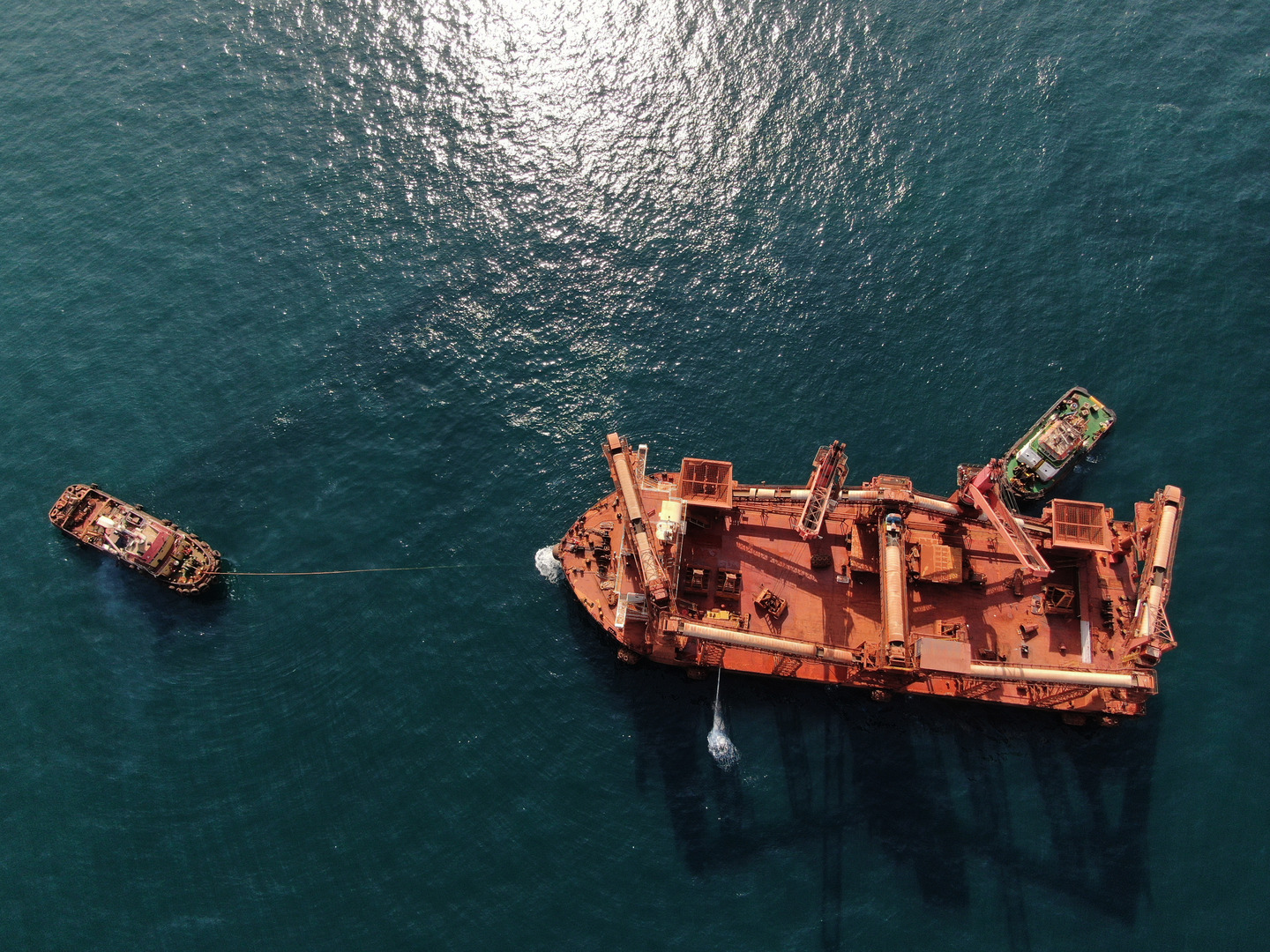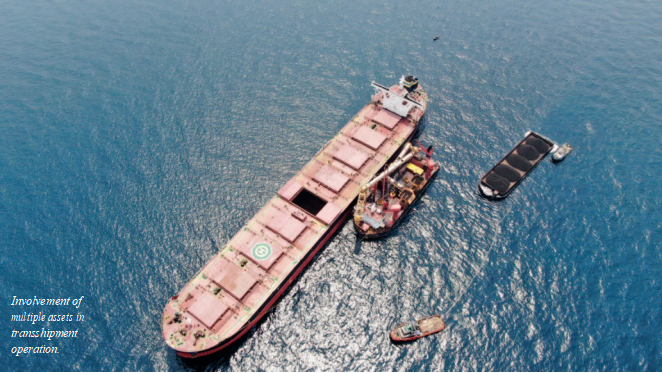Emissions into the environment are nowadays the focal point for almost all industries across the world, including maritime logistics which contributes to about 80% of world trade and with dry bulk commodities accounting for more than 50% of the seaborne trade.
Transshippers, which are a vital part of the offshore logistics of dry bulk commodities, must fulfill its part in the ongoing pursuit of sustainability and efficiency.
Shi.E.L.D. Services, thanks to its extensive experience in the field, is committed to guaranteeing optimal efficiency of the transshippers providing the ship owners with actionable insights into lower carbon emissions without affecting the overall performance.
Sustainability and efficiency at a crossroads
Lower emissions can be achieved in the first place by replacing fossil fuels with carbon-neutral fuels. However, as much as these alternative fuels are emerging and becoming more available, their implement- ation and distribution networks are not growing fast enough to meet the equivalent economies of fossil fuels. It may take an ample amount of time before these alternative sources become an effective solution.
Another factor to be considered is that offshore logistics projects usually take place in remote locations where the availability of traditional fuel is often critical, and the procurement of alternative fuels would be even more challenging.
Among all dry bulk cargoes being transported, coal makes up a major percentage as a primary source of raw materials. As of today’s outlook of the market, it is impossible to overlook its industrial significance despite the contrasting demands of decarbonization. However, industries and owners can still find an efficient way to reduce emissions into the environment due to its uses.
While still working towards the implementation of alternative energy sources on board transshippers, Shi.E.L.D. Services, as designer and technical manager of transshippers that handles coal besides other commodities, is pursuing other ways to reduce emissions while maintaining and even improving the efficiency of its managed assets. Of the many, three main attributes of this plan are discussed below.
1. Optimization of operations
Offshore logistics is composed of different phases. In case of export of cargo, the most important activities are:
- loading shuttle vessels at the jetty;
- transporting cargo from the jetty to the offshore location;
- transferring the cargo from the shuttle vessels into the bulk carriers;
- the back-and-forth voyages of the shuttle vessels between the port and the OGV.
Monitoring this entire supply chain helps identify bottlenecks or activities that slow down the process and are not directly connected to the operational activities.
“A smooth operational flow is the deciding factor for good performance; hence each phase needs to be performed at its maximum efficiency. To ensure this, we adopt a variety of strategies and tools, one of these tools being Spinergie .This helps us monitor in real time the status of each asset of the fleet and allows us to promptly identify those activities which are delaying the operations. The possibility to intervene in a short time to assess the root causes of delays makes it possible to rectify and consumption, which is the quantity of fuel used for each tonne of cargo handled. In the same industry, we are also recording demands for investing in fuel-saving equipment which we support.’, concludes Tersalvi.
2. Maintenance to ensure the efficiency of equipment
Transshippers require extensive maintenance, and the costs may go up very quickly if equipment breaks down at sea and in remote locations, calling for emergency repairs. This leads to interruptions in the transshipment operations accompanied by additional costs due to fuel consumed in the meantime. In a wider lens, the operational progress of the entire fleet of vessels depends on efficient repair.
A maintenance plan, which is custom developed by Shi.E.L.D. Services engineers for each vessel system, includes simple day- to-day activities and more complex maintenance jobs or replacement of critical components to be carried out at longer intervals.
The maintenance strategy adopted by Shi.E.L.D. Services proactively relies on a combination of the following recognized industry standards:
- Preventive (or planned) mainten-ance, which is carried out at predetermined intervals, usually according to the instructions of the manufacturer.
- Risk-based maintenance, where the equipment is considered in a wider context of operation, environmental, and process conditions, based on which the maintenance programme is defined.
- Predictive (or condition-based) maintenance, where the performance of the equipment is monitored, and maintenance is carried out when the observed parameters deviate from the set baseline.
In addition to the above-discussed parameters which are widely used in the industry, laytime and shipments are also important but less discussed topics today. Efficient and cumulative shipments assure both timely availability of the components onboard and reduction of emissions throughout the supplying process.
Over time, the efficiency of systems degrades. This can be seen not only in terms of lower performance but also in higher specific fuel consumption. Therefore, every component of the vessel system is monitored and maintained according to the tailored maintenance plan developed for it.
The benefits are evident. Effective maintenance ensures that the equipment lasts longer, the inventory is optimized, and reduces unplanned maintenance in favour of scheduled maintenance, which is easier to manage and more effective to control. But it also gives a few advantages in terms of fuel savings as well:
- Fewer breakdowns result in less specific fuel consumption for the period when the transshipper and the other vessels are in operation.
- Higher efficiency of the equipment means that less power, and therefore less fuel, is required for the equipment to produce the same amount of work.
3. Innovative equipment design
Material handling on a transshipper requires various pieces of equipment like cranes, grabs, hoppers, conveyors, generators etc. to transfer cargo from one vessel to another. The selection of the equipment therefore plays a role in the transshipment performance which causes fuel consumption reduction.
For example, a grab of new design which provides a higher payload and lower opening/closing times, guarantees a higher quantity of cargo handled for each crane cycle. This results in less specific fuel consumption and overall lower emissions.
‘The same principle applies to all other main equipment being it a crane with higher hoisting and lowering speeds or a properly designed conveyor system. Selecting efficient equipment gives an indubitable return on the investment.’, says Tersalvi.
Conclusion
Shi.E.L.D. Services’ approach to achieving higher efficiency through optimization of the operations, proper maintenance plans, and selection of effective equipment gives the company’s clients the advantage in the current transitional and competitive market. Despite the increasing restrictions imposed by the international regulations, it is still possible to achieve the desired high performance ensuring lower operational costs and carbon emissions, thanks to accurate management and use of the proper tools.


